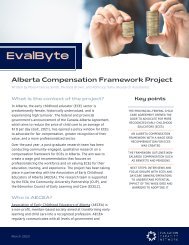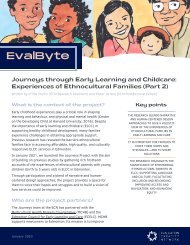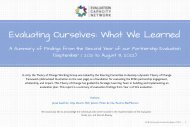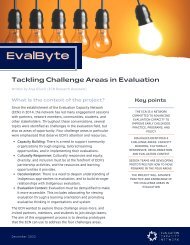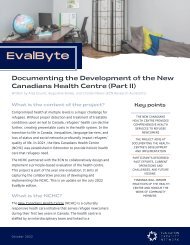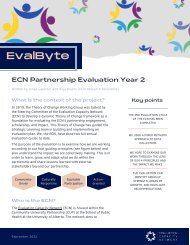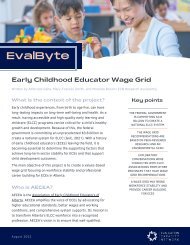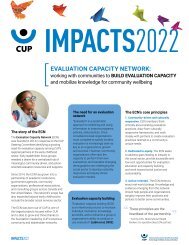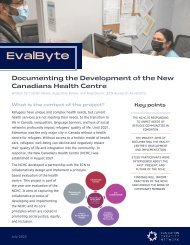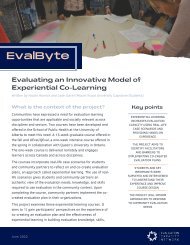Research Report
You also want an ePaper? Increase the reach of your titles
YUMPU automatically turns print PDFs into web optimized ePapers that Google loves.
2015/<br />
2016<br />
<strong>Report</strong>
In 1912, Henry Marshall Tory<br />
established the Department of<br />
Extension at the University of Alberta<br />
to “take the university to the people” because he believed that<br />
valuable knowledge and insights into social issues were co-located<br />
in the communities in which the university lived. In other words,<br />
the university is a community member, and an important resource,<br />
like every other member. Tory was dedicated to building an institution<br />
that was socially responsible, founded on equitable access to learning<br />
and knowledge creation.<br />
Dr. Katy Campbell<br />
Dean, Faculty of Extension<br />
The Faculty of Extension has always been involved in community<br />
building, through its programs, partnerships, relationships, and<br />
engagement scholarship. As one of the core faculties of the University<br />
of Alberta, we are proud to be part of the global movement of engaged<br />
universities. The Talloires Network, for example, is an organization<br />
that “envisions universities around the world as dynamic forces in their<br />
societies,” incorporating community engagement in their teaching<br />
and research missions. What does that mean? It means mutual learning<br />
and reciprocity between communities and scholars. It means diversity in<br />
perspectives and approaches to engagement. It means that universities<br />
and communities work together to build social capacity.<br />
With engagement as a framework, the Faculty of Extension has been<br />
able to initiate, facilitate, and support our communities, including<br />
those inside the university, to tackle common societal issues that<br />
are global in nature and local in impact. Extension scholars partner<br />
with organizations to end poverty, and with rural and First Nations<br />
communities to advocate for digital access. They ally with Métis leaders<br />
to empower youth, and engage with immigrant families to address the<br />
challenges of raising multilingual families. They search for sustainable<br />
strategies that could help communities plagued by boom-and-bust<br />
economies. You will read of these and other made-in-Extension<br />
projects in this report, which we are excited to share with you.
The Faculty of Extension plays a unique,<br />
distinguishable role in the University<br />
of Alberta and in our communities.<br />
We are the only post-secondary faculty in Canada with a primary<br />
research mandate of engagement scholarship. Our mission is to<br />
provide leadership for social and individual betterment through<br />
community-university engagement. Our researchers partner with<br />
communities to undertake engaged and collaborative research,<br />
with the goal of mobilizing positive changes at personal, social,<br />
and system levels, as well as developing a better understanding of<br />
how communities and universities can work together to address<br />
key societal issues.<br />
The theme of this new research report is social justice. The stories<br />
featured highlight some of the great work accomplished by our<br />
researchers over the past few years. From advancing food security<br />
and empowering communities, to committing to end poverty in<br />
Edmonton, our researchers are working to tackle the social challenges<br />
and inequities of our time. Importantly, none of this work would be<br />
possible without the support, trust, and expertise of our community<br />
partners, as we continue to build these sustainable partnerships to<br />
inform and mobilize our work.<br />
Dr. Yoshi Iwasaki<br />
Associate Dean, <strong>Research</strong> (2015/2016)<br />
As I reflect back on my time as Associate Dean, <strong>Research</strong>, I am very<br />
proud to have witnessed this meaningful and impactful work, and I<br />
look forward to seeing what’s next for this exceptionally talented<br />
group of engagement scholars. Together, we hope to build a bright,<br />
empowering, and flourishing future!
Mothers and<br />
mother tongues<br />
Mobilizing family-generated knowledge<br />
for heritage language development<br />
Immigrant parents know the drill: talk to your schoolaged<br />
kid in your native language, and chances are the<br />
child will reply in English. Repeatedly. Despite gentle<br />
encouragement or heartfelt pleas. Raising a multilingual<br />
child—and keeping a heritage language alive at<br />
home—is not an easy task. That is true of families<br />
where both parents share a mother tongue, but even<br />
more so for mixed, interlingual couples, a category<br />
that has been steadily on the rise in Canada according<br />
to census data. Yet, not much is known about the<br />
unique challenges faced by this type of family.<br />
“Families of mixed linguistic backgrounds are minimally<br />
represented in the literature,” says Martin Guardado,<br />
academic director of Extension’s English Language<br />
School. Along with Rika Tsushima (a PhD candidate at<br />
McGill University), Guardado is currently wrapping up<br />
a study funded by a SSHRC grant, Allophone Mothers:<br />
Japanese Female Immigrants’ Perspectives on Heritage<br />
Language, a project based on the experience of<br />
Japanese-descent mothers living in Montreal.<br />
“Trying to ensure that your child will grow up fluent<br />
in your heritage language is often an emotionally<br />
demanding and labour-intensive task,” explains<br />
Guardado. For the Japanese mothers in the study,<br />
the daunting task at hand is to keep the little ones<br />
fluent in Japanese while the children are also<br />
expected to learn English, do their schooling in<br />
French, and—in many cases—speak their father’s<br />
language.<br />
Why do these mothers want their children to speak<br />
Japanese? Passing on a cultural legacy is one of the<br />
reasons. Socializing the child with the extended family<br />
back home is another. But maybe the most compelling<br />
force powering their efforts is the bond they’ll be able<br />
to establish with their sons and daughters, one that’s<br />
filtered by the very notion of identity that is conferred<br />
by language. One of the participants in the study<br />
gives an eloquent example of this issue when she says:<br />
“Well, it’s my language, isn’t it? My words. Japanese is<br />
not just a tool, but myself. Myself. So, if it’s rejected, it<br />
would shock me as if I were rejected by [my children].”<br />
Providing expert advice<br />
Knowledge mobilization is a crucial component of this<br />
project, which was conceived not only as a means to<br />
learn along with the mothers, but also to develop<br />
information-sharing opportunities and provide researchbased<br />
advice for the target population. With this goal<br />
in mind, booklets and workshops with the mothers<br />
were designed as one of the study’s phases, providing<br />
participants with much-needed guidance on how to<br />
navigate the everyday Babel of interlingual families.<br />
“Participants were very vocal about their unsuccessful<br />
efforts to access good expert advice,” says Guardado.<br />
“Perhaps the most powerful research implication<br />
emerging from this study concerns the need for<br />
researchers to build appropriate knowledge translation<br />
and mobilization components into their study designs.”<br />
Among other things, the workshops served to debunk<br />
a few multilingual education myths that are a source<br />
of great anxiety for many families. One such myth,<br />
sometimes passed along by concerned friends and<br />
school teachers, is that speaking different languages<br />
at home will have negative consequences in the child’s<br />
performance at school. “In fact, multilingual children<br />
are nearly always better than their monolingual friends<br />
at reading and writing,” says Guardado.<br />
4
“The workshop was a great<br />
opportunity and inspired my<br />
partner and I to think more<br />
seriously about our multilingual<br />
education strategies.”<br />
Workshop participant
A road map<br />
to end poverty<br />
Listening, learning, and collaborating to<br />
build a just and prosperous society for all<br />
Creating a city with no poverty and where all have<br />
equal opportunities to thrive: that’s the goal the<br />
EndPovertyEdmonton (EPE) initiative is striving to<br />
achieve within one generation.<br />
Poverty is one of the greatest social challenges of our<br />
era, and many Canadian leaders and municipalities<br />
have made commitments and formed working groups<br />
to address it in their areas. Edmonton’s approach,<br />
however, is unique in two ways. Firstly, EPE has<br />
made a bold pledge to eliminate, not merely reduce<br />
or alleviate, poverty in our city. Further, EPE has<br />
committed to reaching this goal through evidencebased<br />
action. Such an ambitious goal calls for<br />
collective community vision and action from diverse<br />
city stakeholders, including business leaders, service<br />
workers, and researchers.<br />
Since 2014, Extension researchers and centres,<br />
including the Centre for Public Involvement (CPI) and<br />
Community-University Partnership for the Study of<br />
Children, Youth, and Families (CUP), have been key<br />
partners in EPE. As consultants and advisors,<br />
Extension researchers have helped develop the initial<br />
EPE Strategy (unanimously approved by City Council<br />
in October 2015) and the Implementation Road Map<br />
(May 2016). This latter document outlines specific,<br />
achievable directions for action over the next five<br />
years, and establishes the structure for a governing<br />
stewardship body to take over management of the<br />
initiative starting January 2017.<br />
Throughout all stages of the initiative, Extension<br />
researchers have brought to the table expertise in<br />
research processes, policy development, community<br />
engagement, and collaboration. Their contributions<br />
have included facilitating community and expert<br />
discussions on practical steps forward, consulting on<br />
governance strategy, as well as mining a povertyrelated<br />
data set to create case stories of families living<br />
in poverty, which have been built into and used to<br />
critically evaluate the content and relevance of the<br />
Strategy and the Road Map.<br />
Our researchers have been champions for evidencebased<br />
action, ensuring that all EPE actions are<br />
grounded in rigorous research, evidence, and the<br />
need for ongoing evaluation. They have brought key<br />
questions to the table, such as: How are Edmontonians<br />
experiencing poverty? What barriers have prevented<br />
them from thriving? How can we measure poverty?<br />
What do we mean when we promise to “lift people<br />
out of poverty?” How will we know we are making an<br />
impact? Thanks to this focus, the principles of research,<br />
evaluation, and accountability are built right into the<br />
Road Map and governance structure.<br />
A shift in policy-making<br />
Maria Mayan, associate professor and CUP assistant<br />
director, has been involved in all stages of this work.<br />
For Mayan, Extension’s involvement in the task force is<br />
a sign of an important shift in the policy development<br />
process. “What is really exciting is that when it comes<br />
to community and EPE, research was welcomed,”<br />
says Mayan. “<strong>Research</strong> was considered important.”<br />
Similarly, Extension’s considerable investment in<br />
EPE is a great example of the faculty’s own strategic<br />
priorities. “This kind of work aligns perfectly with our<br />
values as researchers,” says Mayan, citing our faculty’s<br />
commitment to community engagement, collaboration,<br />
social justice, and research-informed policy.<br />
6
“Having Faculty of Extension<br />
representatives around the<br />
EPE task force table with<br />
some of Edmonton’s most<br />
influential community<br />
stakeholders is a powerful<br />
example of the university’s<br />
commitment to community<br />
service, and of the power of<br />
university and community<br />
collective action.”<br />
Martin-Garber Conrad, CEO<br />
Edmonton Community Foundation<br />
Mayan is currently working alongside city staff and<br />
stakeholders on a transitional committee responsible<br />
for getting key processes and tools in place for the<br />
incoming stewardship body. This includes developing<br />
a comprehensive evaluation framework, including a<br />
theory of change and logic model, shared measurement<br />
system, and robust measure of poverty. These tools will<br />
ensure that EPE is able to measure the long-term impact<br />
and relevance of our collective efforts.<br />
“We have created a strong foundation for the strategy<br />
to come to life,” says Mayan. “The governance structure<br />
of the stewardship body, alongside the Strategy, Road<br />
Map, tools, partnerships, and the momentum we have<br />
generated to date have set the initiative up for success.”<br />
7
Fighting sexual exploitation<br />
with mobile technology<br />
<strong>Research</strong> collaboration uses messaging<br />
to reach out to sex workers<br />
A sex worker is checking the text messages on her<br />
disposable “burner” phone. Her phone number was one<br />
of many advertised on the classified ads section of an<br />
adult-only website. She scrolls down the screen looking<br />
for messages from clients when an unexpected text pops<br />
up: “We’re here to help you if you need it.” The text<br />
also includes the website address and phone number<br />
of the Centre to End All Sexual Exploitation (CEASE),<br />
an Edmonton-based organization that aims to reduce<br />
harm and create long-term solutions for individuals and<br />
communities caught in the web of sexual exploitation.<br />
Since 2012, CEASE and the Faculty of Extension<br />
have been working together on Project Backpage,<br />
a community-university research collaboration to explore<br />
the use of mobile phone text messaging as a method<br />
of making initial contact with potential victims of sexual<br />
exploitation and human trafficking, to provide them<br />
with support information.<br />
The project is a technology-based response to a<br />
challenge also created by technology: the migration of<br />
much of the sex trade from the physical space of the<br />
streets to the screens of adult websites where online<br />
advertisements are posted. “Outreach in this area<br />
used to be an activity that involved making face-to-face<br />
contact with sex workers on the streets,” says associate<br />
professor Gordon Gow, director of the Master of Arts in<br />
Communications and Technology (MACT) at the Faculty<br />
of Extension. “In a growing number of cases, however,<br />
this kind of contact is now difficult,” he explains.<br />
The messaging campaigns are facilitated by the MARS<br />
(Mobile Applications for <strong>Research</strong> Support) Lab, a set<br />
of resources and expertise established in 2011 as part<br />
of the MACT program. Telephone numbers are drawn<br />
from classified ads at Backpage.com with the help of<br />
GSA Email Spider, an application that automatically<br />
extracts phone numbers from websites. Campaigns are<br />
then built and sent using FrontlineSMS, a free, opensource<br />
text messaging application created for community<br />
development projects, which turns a computer connected<br />
to a mobile phone into a two-way messaging hub.<br />
Each campaign sends messages to about 300 numbers.<br />
To date, over 5,000 messages have been sent through<br />
the project.<br />
One-on-one interaction<br />
“The text messages are intended only as an initial<br />
contact,” says Gow. “They’re not a substitute to one-onone<br />
interaction.” An increase in one-on-one interactions,<br />
in fact, is the primary goal of the project—and one<br />
that’s not easy to measure. “It is difficult to know in any<br />
given case whether contact between CEASE and a client<br />
is due to them receiving a message,” he explains. But<br />
even though numbers may be hard to get, there were<br />
several occasions in which the messages are mentioned<br />
as the “click” moment that lead someone to call the<br />
CEASE line or show up for a face-to-face meeting.<br />
The campaigns are structured around a MACT elective,<br />
a special-topics course that explores digital technology<br />
as a means of enhancing outreach communications.<br />
“The students work with CEASE and me to plan and<br />
design the communication campaign,” explains Gow.<br />
“It’s a great opportunity for them, and it helps CEASE<br />
with their outreach strategy.”<br />
A development in the works at Project Backpage will<br />
be extending it regionally to make it Alberta-based:<br />
“We hope to build connections with organizations<br />
in Calgary, Lethbridge, and other cities across the<br />
province.”<br />
8
“Project Backpage has proven<br />
to be an invaluable tool in<br />
our ability to connect with<br />
vulnerable persons through<br />
technology. We are appreciative<br />
of the partnership between<br />
CEASE and UAlberta and<br />
look forward to continued<br />
collaboration.”<br />
Centre to End All Sexual Exploitation
From farm to table<br />
Crossing silos to strengthen local<br />
food systems<br />
How would you like to eat healthier, support a<br />
sustainable and environmentally friendly industry,<br />
strengthen your local economy, and foster stronger<br />
communities?<br />
According to Mary Beckie, associate professor<br />
specializing in local and alternative agri-food systems,<br />
these benefits may be more attainable than you think.<br />
As the Western Canada academic lead for the Food:<br />
Locally Embedded, Globally Engaged (FLEdGE)<br />
research partnership, Beckie is exploring the current<br />
and potential role of community food initiatives in<br />
Alberta and across Canada. The international FLEdGE<br />
network of researchers was kick-started by a SSHRC<br />
partnership grant, bringing together experts and<br />
community leaders from across Canada, Europe, and<br />
the U.S. Their goals? To enhance the impact of local<br />
food production, raise awareness of the benefits of local<br />
food systems, and help shape future agricultural policy.<br />
Sustainability of the food system is a pressing social<br />
issue, and local food production represents a critical<br />
counterpoint to conventional industrial agriculture.<br />
Due to benefits such as superior freshness and taste,<br />
reduced carbon emissions, higher and more reliable<br />
incomes for small-scale farmers, increased food security,<br />
and overall stronger local economies, locally sourced<br />
food has experienced a tremendous and continuous<br />
surge of popularity across Canada. Alberta is no<br />
exception to this trend—even during times of economic<br />
recession, local food distribution through farmers’<br />
markets, community-supported agriculture (CSA) farms,<br />
and farm-to-table restaurants has continued to thrive.<br />
Beckie is careful to point out that local food systems do<br />
have limitations. For one, Alberta has a cold climate,<br />
and cannot sustainably grow food year-round. Further,<br />
the current infrastructure for growing, processing, and<br />
distributing food within Western Canada is fragmented<br />
geographically and across sectors, and lacks the scale<br />
and governance structure to keep up with increasing<br />
consumer demand. To move beyond these barriers,<br />
she says, “we need to grow our local, regionalized<br />
food systems, and become more sophisticated about<br />
how they are structured.”<br />
Case studies<br />
Beckie’s research began with an environmental scan<br />
to map existing and emerging initiatives in Alberta<br />
and neighbouring regions. She and her team are<br />
also developing a handful of in-depth case studies<br />
to showcase and evaluate innovative approaches to<br />
integrating and strengthening local food systems.<br />
One featured case study is Lady Flower Gardens,<br />
a program that invites disadvantaged community<br />
members to tend a communal plot of land. Participants<br />
build relationships and make a meaningful contribution<br />
to their community. They are also invited to take home<br />
a portion of the produce they cultivate, while the rest<br />
is donated to local charities and food banks.<br />
This research, which Beckie will continue to develop<br />
over the next five years, is also setting the stage for<br />
her larger-scale goals, to help Alberta’s local food<br />
stakeholders scale their operations up and out. She has<br />
already brought on board numerous organizations and<br />
academic partners, and plans to continue to develop<br />
and expand this network to engage more stakeholders.<br />
Next steps have included partnering with Northlands to<br />
evaluate and strengthen their Alberta Flavour initiative,<br />
a working group to increase institutional procurement<br />
10
“FLEdGE connects local efforts<br />
to national and international<br />
leaders, all trying to build<br />
more sustainable food systems.<br />
FLEdGE also allows us to<br />
research, document, and share<br />
how organizational changes<br />
impact our community. It is an<br />
exciting project to be part of.”<br />
Jessie Radies, Local Food Associate - Agriculture<br />
Northlands<br />
of local foods through relationship-building and a<br />
dedicated online platform. Beckie has also joined<br />
forces with Alberta Food Matters (AFM) to co-host<br />
Cultivating Connections, a provincewide forum that<br />
will, in February 2017, bring together farmers,<br />
processors, distributors, community and social justice<br />
groups, food retailers, chefs, and researchers.<br />
Attendees will forge new relationships, identify<br />
opportunities to collaborate, and, as Beckie hopes,<br />
“inspire new and innovative initiatives and grow<br />
vibrant and sustainable local food systems.”<br />
Cultivating Connections and the FLEdGE project as a<br />
whole represent a step forward in a movement that has<br />
been a long time coming in Alberta. “I think it’s time,”<br />
concludes Beckie. “This is something that is not going<br />
away. Demand for local food is only going to become<br />
more prevalent, as people are more concerned about<br />
where their food is from.” As people are able to better<br />
understand the journey their food made to get to their<br />
plate, who was involved in its production, and how that<br />
process impacted their lives and their communities, they<br />
can make more informed decisions about what to eat.<br />
11
A summer<br />
to remember<br />
From resilience training to<br />
community empowerment<br />
The Alberta Métis Settlements are unique, self-governing<br />
communities in Canada. Located across northern<br />
Alberta, they boast rich cultural traditions and histories<br />
that blend First Nations and Euro-Canadian values,<br />
spiritual beliefs, and customs.<br />
In 2010, Extension researchers Fay Fletcher and Alicia<br />
Hibbert approached the Buffalo Lake Métis Settlement,<br />
seeking a partnership to develop a life skills program for<br />
local children and youth. Beginning with a communitydriven<br />
needs assessment, Fletcher and her team worked<br />
with local leaders to develop a summer camp curriculum<br />
from scratch, focusing on issues identified through<br />
conversations with residents, youth, and Elders.<br />
The original Métis Settlements Life Skills Journey (LSJ)<br />
camp curriculum, still in use today, was designed to<br />
help children grow their capacity to resist negative<br />
behaviour such as smoking, drinking, and bullying.<br />
Campers build relationships and confidence through<br />
indoor and outdoor activities that range from beading<br />
and sharing circles to shelter-building, while facilitators<br />
deliver a range of resiliency-focused learning modules,<br />
such as “kinship,” “communication,” and “community.”<br />
Six years later and the program is still going strong,<br />
having expanded from Buffalo Lake to include<br />
Kikino, Elizabeth, and Fishing Lake Métis Settlements,<br />
and engaging hundreds of campers and facilitators<br />
to date. The research team has become an integral<br />
presence in the participant communities, fostering<br />
strong ties with camp facilitators, teachers, Elders,<br />
and other local leaders.<br />
In addition to developing and delivering research-based<br />
resiliency training, Fletcher has been collecting data<br />
with each community to better understand the impact<br />
of the camps on the campers, facilitators, and the<br />
communities as a whole. Each year, the team conducts<br />
focus groups, surveys, and other research activities to<br />
gauge the personal growth among participants (using<br />
the validated Resiliency Framework), tracking positive<br />
gains in participants’ capacities for reflective thinking,<br />
confidence, and relationship-building.<br />
Handing over the reins<br />
To any casual observer, however, it is clear that the<br />
Life Skills Journey team has accomplished a whole<br />
lot more than research. Over the years, Fletcher and<br />
her team have cultivated an environment of growth,<br />
shared learning, and mutual trust in each Life Skills<br />
Journey site. All findings are shared with, and owned<br />
by, the settlements. Further, as communities have seen<br />
the positive results and feedback from the camps,<br />
they have become more invested in the research<br />
process and program success. “It’s an exciting time,”<br />
remarks Amanda MacRae, a project coordinator for<br />
LSJ. “This year we are seeing more initiative from some<br />
of our participants, greater collaboration and resourcesharing<br />
between communities, and even independent<br />
community-based research. We [the university-based<br />
researchers] are naturally starting to hand over the reins,<br />
continuing to support the community without providing<br />
all the answers or dictating project direction.”<br />
As research project lead, Hibbert notes that this shift<br />
is an important one, especially in our current funding<br />
environment. “We have been lucky to receive ongoing<br />
grants and support from Alberta Health Services and<br />
the Alberta Centre for Child, Family, and Community<br />
<strong>Research</strong>. However, there’s no guarantee we will<br />
be able to maintain this level of involvement for an<br />
extended time.” As competition for research and<br />
community development grants increases, the LSJ team<br />
is focusing its efforts toward project sustainability.<br />
12
“For me, I think just<br />
throughout the last years,<br />
[I learned about] becoming<br />
more of a leader, I guess...<br />
This just gave me the<br />
opportunity in a safe place to<br />
learn those skills and to get<br />
better at them.”<br />
Facilitator, 2015<br />
Métis Settlements Life Skills Journey<br />
According to Hibbert and MacRae, the team is<br />
maintaining an open line of communication and<br />
partnership, but rethinking their role in the community.<br />
For example, the team has trained some of the longerstanding<br />
facilitators to serve as “lead facilitators.”<br />
These individuals are now equipped to train new<br />
camp facilitators and staff to deliver LSJ in future<br />
years. This “train-the-trainer” approach will not only<br />
support program longevity, but also support facilitators’<br />
professional development and inject valuable leadership<br />
skills into the communities. Communities are also taking<br />
on more responsibility in terms of logistics and program<br />
delivery. In the meantime, the LSJ team is looking for<br />
opportunities to serve in an advocacy capacity,<br />
bringing awareness to community issues amongst<br />
academia and potential funders.<br />
For Fletcher and the rest of the LSJ team, it’s been<br />
hard to let go. “We have built such strong and trusting<br />
relationships in these communities,” says Fletcher.<br />
However, this transitional process is a learning<br />
opportunity, for the communities as well as for the<br />
university. “Through this transition, we hope to better<br />
understand how academics and funders can work<br />
collaboratively with communities, to empower them<br />
to build their own agency and self-determination to<br />
shape how their community grows and improves.”<br />
13
Digital divides<br />
and destinies<br />
Technology ownership and agency in<br />
rural and First Nations communities<br />
Our world is fast becoming one driven by innovation.<br />
Thanks to faster and more efficient telephone, cable,<br />
and broadband internet connectivity, many Canadians<br />
are reaping benefits such as increased access<br />
to government and social services, rapid remote<br />
communication, expanded job and sales markets,<br />
and limitless opportunities for learning.<br />
But what about the people and communities that are<br />
excluded from this technological revolution? What about<br />
communities that, due to a remote location or small<br />
population, do not present a strong enough business<br />
case to attract investments from big telecommunications<br />
companies? Communities that lack the infrastructure<br />
needed to truly take advantage of modern digital<br />
technology? Communities that want to take control<br />
of the solutions to these challenges to shape their<br />
digital destinies?<br />
Rob McMahon has made these questions the focus<br />
of his research. With a background in technology<br />
and communications research, McMahon is the<br />
coordinator for the First Mile Connectivity Consortium<br />
and a co-investigator on the associated First Nations<br />
Innovation (FNI) research initiative. First Mile is a nonprofit<br />
organization that celebrates and advocates for<br />
technological capacity and independence within First<br />
Nations communities. Their activities are informed<br />
by the FNI research team, who explore how remote<br />
and rural First Nation communities are currently using<br />
broadband and other technologies to access e-health,<br />
e-learning, e-business, and other services, and how<br />
these networks can be expanded and leveraged.<br />
The FNI research approach is participatory and<br />
community-driven. “The communities and the technology<br />
organizations they have set up,” McMahon notes,<br />
“are our partners. Each one has unique needs and<br />
strengths. We seek to honour that.” McMahon and his<br />
FNI colleagues employ a flexible research process,<br />
co-developed with community partners, that begins<br />
with a thorough inventory of existing technology<br />
infrastructure, such as broadband or cellphone towers,<br />
and assessment of how it is used. They then work with<br />
regional and local partners to explore new potential<br />
applications for and additions to the existing capacity<br />
and connectivity. This may include identifying funding<br />
or policy supports for new infrastructure, or training<br />
community members in valuable digital literacies and<br />
skills, such as assessing technology needs, accessing<br />
equal data usage records, setting up digital applications,<br />
and advocating for fair pricing in their communities.<br />
New partnerships<br />
Although First Mile supports communities across<br />
Canada, much of the FNI research to date has been<br />
centred in Ontario, Quebec, and Atlantic Canada.<br />
As a newly appointed Extension faculty member,<br />
McMahon is bringing this research focus and process<br />
to small-town Alberta. He has begun by building<br />
relationships with local leaders at the Buffalo Lake Métis<br />
Settlement, the first step of an in-depth study. “Buffalo<br />
Lake,” explains McMahon, “presents an exciting<br />
opportunity to adapt our partnership model with a Métis<br />
community,” a uniquely Canadian cultural context not<br />
yet explored by other FNI researchers. McMahon is<br />
also partnering with the University of Alberta School of<br />
Library and Information Studies and the Alberta Ministry<br />
of Economic Development and Trade to develop an online<br />
community broadband resource portal and toolkit. With<br />
funding support from the Kule Institute for Advanced<br />
Study and the U of A Libraries, their team will curate<br />
14
“Our goal at the First Nations<br />
Education Council is to support<br />
First Nations to achieve full<br />
jurisdiction over their education.<br />
Through partnerships such as<br />
First Mile and the FNI project,<br />
concrete information is produced<br />
in close collaboration with our<br />
members that aims to empower<br />
our communities to offer their<br />
children the best opportunities<br />
in education and life.”<br />
Tim Whiteduck<br />
Techonology Director, First Nations Education Council<br />
success stories, business models, policy briefs, academic<br />
research, and training tools to help leaders in rural<br />
communities improve local access to broadband.<br />
So why does this research matter? Aside from the<br />
immediate benefit of improving communities’ access<br />
to much-needed services, it also empowers people<br />
living in rural and remote areas to actively participate<br />
in the wider world. As McMahon says, “I think these<br />
communities have a lot to offer. They have their own<br />
capacities, their own knowledge that can benefit the<br />
rest of society.”<br />
Further, through his focus on community empowerment,<br />
McMahon works with participating communities<br />
to identify ways to advocate for themselves, make<br />
informed decisions, and take charge of their digital<br />
futures. “In the near future,” he says, “everything<br />
will be connected; everything will require access to<br />
internet and telecommunications. There is tremendous<br />
opportunity here, in Canada, to set the stage for<br />
digital independence on a global level.” The lessons<br />
that we learn with First Nations through FNI can help<br />
communities around the world—communities that are<br />
small, rural, and perhaps excluded from the digital<br />
revolution—discover their own creative pathways<br />
to digital empowerment.<br />
15
Small communities<br />
seeking big changes<br />
Resilience, adaptability, and self-determination<br />
in boom and bust communities<br />
Western Canada is known as one of the world’s largest<br />
producers of energy and agricultural goods. Boasting<br />
rich natural resources—including coal, oil, wheat,<br />
aluminum, fish, and lumber—the provinces of Alberta<br />
and British Columbia have a long history of attracting<br />
shrewd investors and prospectors, seeking to make<br />
their fortune in remote and rural communities. Many of<br />
these communities rely on a single or limited resource,<br />
making them vulnerable to periods of extreme growth<br />
and decline as resource availability, global markets,<br />
and other factors shift over time. Although larger cities,<br />
such as Edmonton and Calgary, are not immune to<br />
the ups and downs of a resource economy, smaller<br />
communities tend to be more vulnerable to the<br />
excitement of “boom” periods and the decline of “bust”<br />
periods, with fewer options available for recovery.<br />
The extreme nature of boom and bust cycles has<br />
become an area of fascination for Kristof Van Assche<br />
and Monica Gruezmacher, researchers for Extension’s<br />
City-Region Studies Centre (CRSC). Alongside a team<br />
from CRSC and several University of Alberta faculties,<br />
Van Assche and Gruezmacher have spent the past<br />
two years embarking on a series of road trips to small<br />
boom and bust communities across Western Canada.<br />
Their goal has been to learn more about how these<br />
places can survive, and even thrive, in the face of<br />
such adverse and unpredictable conditions, and what<br />
other communities and academics can learn from<br />
their past experiences.<br />
According to this dynamic team, much of the existing<br />
research on boom and bust dynamics and sustainable<br />
planning tends to be prescriptive or only focused on<br />
part of the problem. In a world where expertise has<br />
become increasingly specialized and quick and easy<br />
answers are highly valued, many “bust” towns that seek<br />
external help are provided with formulaic processes and<br />
tools that don’t necessarily translate to their unique set of<br />
experiences and contexts. Says Van Assche, “We have<br />
found such an amazing diversity of experiences, beliefs,<br />
stories, and creative governance structures. Each place<br />
we have studied has created its own story. No one<br />
‘recipe’ for overcoming a bust could possibly succeed<br />
in all of them.” For example, a sustainability strategy<br />
that works in a coal mining town facing reduced demand<br />
would not work in an old forestry town struck by forest<br />
fires. Nor would the residents of those towns necessarily<br />
even agree on what success means. “Success” is a<br />
subjective concept, largely shaped by the stories that<br />
communities tell about themselves. Residents in that mining<br />
town may equate success with increased mining activity,<br />
and find it difficult turn to tourism or eco-farming as<br />
their main economic activity.<br />
Self-analysis and other tools<br />
of the trade<br />
Van Assche and Gruezmacher understand that<br />
communities have a right to set their own path, and that<br />
decisions about a community’s future should be based<br />
on serious self-analysis and a critical look at their past<br />
and the current context. Outsiders and experts, including<br />
academics, can help in this process by offering insights<br />
and structure for self-analysis. Self-analysis is far from<br />
simple, and can often be painful or exacerbate internal<br />
conflict. However, when properly managed, this process<br />
is an invaluable tool for helping the community overcome<br />
challenges and move forward.<br />
The researchers have developed tools and resources to<br />
guide communities through this challenging process of self-<br />
16
“Our need to understand<br />
and adjust to the highs and<br />
lows of economic cycles has<br />
only been magnified in recent<br />
years. Citizens, including<br />
leaders in Alberta and<br />
northern British Columbia,<br />
should welcome this<br />
contribution to what<br />
we know.”<br />
Ted Binnema, Historian<br />
University of Northern British Columbia<br />
analysis and strategic planning, and are now sharing<br />
them publicly with several of their partner communities.<br />
Rather than outlining specific steps to reinvigorate<br />
the community, they instead provide the background<br />
and structure for critical thinking and engagement.<br />
Communities can draw on their research to identify<br />
factors that caused the bust, set goals for the future,<br />
and develop a strategy to achieve that vision.<br />
By offering an alternative to pre-packaged solutions<br />
and equipping towns with the internal capacity to<br />
review and critically reflect on their circumstances,<br />
Van Assche and Gruezmacher hope to influence<br />
how communities are able to manage radical ups<br />
and downs, and ultimately become more resilient.<br />
“Communities are constantly developing and<br />
changing,” Gruezmacher explains. “There’s never<br />
any guarantee that circumstances or community values<br />
and desires won’t shift over time. Governance is<br />
adaptive and in constant co-evolution.” Their research<br />
presents an opportunity to understand how the different<br />
contexts and dimensions of governance can change<br />
over time, and how a community can manage these<br />
changes to shape its own destiny.<br />
17
The kids are<br />
(not) all right<br />
Project puts young children’s<br />
struggles on the map<br />
When young Albertans blow out the candles on<br />
their fifth birthday cake—around the time they will be<br />
entering school—how many of them have reached<br />
the developmental milestones expected for their age?<br />
If you were to ask this question to researcher Susan<br />
Lynch a few years ago, she would have guessed that<br />
most of our kids (around 60% to 65% of them) would<br />
be developing the way they were supposed to. That was<br />
before Lynch started at the helm of ECMap, a multi-year<br />
project that looked into the development of pre-school<br />
children across the province.<br />
The Early Childhood Development Mapping (ECMap)<br />
project painted a province-wide picture of how children<br />
are developing before they go to school. But the picture<br />
that emerged from the study wasn’t a pretty one. “I<br />
was surprised when I learned from our work that only<br />
46% of the children were developing appropriately,”<br />
says Lynch. “There are many children with poor<br />
developmental outcomes in every community of<br />
Alberta. No community is exempt.”<br />
Financed by the government of Alberta, ECMap was<br />
a $12 million large-scale population study that, for the<br />
first time, comprehensively measured Alberta children in<br />
five areas of development: physical, social, emotional,<br />
language/thinking skills, and communication/<br />
general knowledge. With the assistance of Alberta’s<br />
kindergarten teachers using the Early Development<br />
Instrument (EDI), data were gathered and analysed on<br />
over 72,000 children during their kindergarten years.<br />
The project allowed for a broad understanding of<br />
how young children are doing in Alberta and how<br />
their development compares to the Canadian norm.<br />
Perhaps more importantly, it generated a detailed map<br />
that provided information at the community level.<br />
“We gave every community their own results and<br />
helped them understand them,” says Lynch. “We also<br />
helped the communities to form coalitions that could<br />
use those results to take action.”<br />
One hundred such coalitions were created during this<br />
process, most of which remained active after project<br />
data collection came to a close in 2014. “One of<br />
the recommendations of our final report was that the<br />
government continue to support the work of the<br />
coalitions, and they have been doing so,” she says.<br />
Keeping track of progress<br />
Another policy recommendation being addressed<br />
was to keep measuring children’s development so that<br />
it could be compared over time against ECMap’s<br />
baseline results. “If you don’t do that, you don’t know<br />
if the things you’re doing to improve the children’s<br />
outcomes are actually making a difference,” explains<br />
Lynch. “Another round of data was picked up just this<br />
year, and the plan is to do it again in another couple<br />
of years.”<br />
ECMap was directed by Susan Lynch and had as coinvestigator<br />
Rebecca Gokiert, an associate professor<br />
at the Faculty of Extension. The project was staffed<br />
by a team of 22 people that included community<br />
development coordinators and specialists in areas such<br />
as test measurement, data analysis, mapping, sociology,<br />
communications, and early childhood development,<br />
among others. The four reports produced by ECMap,<br />
as well as LiveAtlas (an interactive map with information<br />
on every community), are available at ecmap.ca.<br />
18
“The ECMap project has<br />
served as an impetus for<br />
community members to take<br />
ownership of their results, as<br />
well as the actions they have<br />
identified to bring change.”<br />
Iris Spurrell, Bowness Montgomery<br />
Early Childhood Coalition, Calgary
Making a difference<br />
through evaluation<br />
An evaluation network to build capacity<br />
in the field of early childhood<br />
There is wide agreement among researchers,<br />
community organizations, governments, and funders<br />
that Early Childhood Development (ECD) programs<br />
and practices work wonders to give vulnerable children<br />
a better chance in life. Whatever happens during the<br />
first five years of age becomes “biologically embedded”<br />
in a child’s brain, often with lifelong consequences.<br />
But negative experiences can be minimized if support<br />
for children and their parents comes early enough.<br />
During this critical time, meaningful evaluation can<br />
guide practice, programs, and policies, providing<br />
answers to the question that underlies the work of<br />
those in the early childhood field: Are we making<br />
a difference in children’s lives?<br />
“Evaluation plays a critical role in the field of ECD,”<br />
says associate professor Rebecca Gokiert. “It helps<br />
to drive funding decisions, to shape public policy, to<br />
improve practice, and to demonstrate accountability.”<br />
As the principal investigator of the Evaluation<br />
Capacity Network (ECN) project, Gokiert has been<br />
working with her team to establish a multidisciplinary<br />
and intersectoral partnership focused on improving<br />
evaluation practices in ECD.<br />
Building evaluation capacity within community<br />
organizations is one of the goals of the project.<br />
“Organizations are expected to evaluate their efforts<br />
and to incorporate those findings into their daily<br />
practices. Given their limited resources, however,<br />
this can prove to be a challenge,” explains Gokiert.<br />
Further complicating matters, the kind of information<br />
collected varies widely between different sectors<br />
(organizations, funders, government, etc.) and levels<br />
(national, provincial, and regional). That’s why another<br />
important objective behind the ECN is to work toward<br />
aligning evaluative thinking across sectors and levels,<br />
so that the puzzle pieces represented by individual sets<br />
of data can be integrated into a meaningful big-picture<br />
view of current ECD practices and results.<br />
Started in 2014, the ECN has engaged 78 different<br />
partner organizations to date, among them community<br />
organizations, funding agencies, government<br />
departments, university faculties, consulting companies,<br />
and municipal services. A first document produced by<br />
the project, the stimulus paper “Advancing Evaluation<br />
Practices in the Field of Early Childhood Development,”<br />
was used as the starting point for community dialogues<br />
attended by 122 participants in Edmonton, Calgary,<br />
Lethbridge, and Grande Prairie. In addition, a survey<br />
distributed to a range of key stakeholders throughout<br />
Alberta generated 340 responses in which individuals<br />
and organizations reflected on knowledge, abilities,<br />
and leadership in evaluating ECD efforts.<br />
Sustainable network<br />
The feedback gathered through the survey, dialogues,<br />
and engagement with organizations will help ECN<br />
researchers establish priorities for building evaluation<br />
capacity in the field of ECD. Rather than a short-term<br />
group formed only to serve the needs of a research<br />
project, the Evaluation Capacity Network is being<br />
developed as a sustainable collective that will provide<br />
resources, deliver training opportunities, and foster<br />
an open dialogue for ongoing change.<br />
Though at the moment the project is focused regionally<br />
and provincially, the ECN intends to engage new<br />
partners from across Canada who share similar<br />
challenges, express common needs, and seek to<br />
strengthen their evaluation capacity and resources.<br />
“The network acts as a central point of contact and<br />
support for those working in ECD,” explains Gokiert.<br />
20
“The Evaluation Capacity<br />
Network will provide our<br />
agency with the resources<br />
it needs to ensure we are<br />
appropriately supporting<br />
our children and youth<br />
and achieving outcomes<br />
that make a difference<br />
in people’s lives.”<br />
Big Brothers Big Sisters of Edmonton and Area<br />
“We are in the process of creating resources to build<br />
evaluation knowledge, skills, and experience. Our work<br />
will ultimately inform and strengthen practice, programs,<br />
and policies for children and families across Canada.”<br />
The ECN is developed through Extension’s Community-<br />
University Partnership for the Study of Children, Youth,<br />
and Families (CUP). Funded by the Social Sciences and<br />
Humanities <strong>Research</strong> Council (SSHRC) and additional<br />
project partners, the study is co-investigated with<br />
Robyn Blackadar, Jason Daniels, Sharla King, Maria<br />
Mayan, Cheryl Poth, Laurie Schnirer, Jane Springett,<br />
and Stanley Varnhagen.<br />
21
Growing up in a<br />
digital world<br />
The good, and bad, impacts of<br />
technology on our children<br />
Technology has become an omnipresent force in the<br />
lives of Canadian children. They bring their phones<br />
to school, they work on computers at school and at<br />
home, they sleep with tablets and other devices on their<br />
bedside table. Almost half of their waking hours, and<br />
those of their parents, are spent in front of a screen.<br />
With such pervasive presence of technology in our<br />
lives, it’s no surprise that there are a lot of strong<br />
opinions about how this new reality is affecting our<br />
younger generation. Many fear that technology is<br />
a peril, one that is holding back social, emotional,<br />
cognitive, and physical development. Spurred on<br />
by media warnings, people also blame exposure<br />
to technology for dangerous behaviours such as<br />
cyberbullying. Others believe technological progress<br />
is inherently good, with benefits such as increased<br />
connectivity and access to information outweighing<br />
any potential risks.<br />
According to Jason Daniels, Extension researcher with<br />
a background in cognitive development, it’s not that<br />
simple. “Technology undoubtedly brings both promise<br />
and peril, benefits and potential risks. The challenge<br />
is looking at a child’s digital life from all angles, to<br />
understand how technology is affecting things like social<br />
connectivity, creativity, problem solving, homework,<br />
identity, and even nutrition and exercise.”<br />
Daniels has dived headfirst into this challenge,<br />
partnering with Harvard University professor Michael<br />
Rich and the Alberta Teachers’ Association (ATA)<br />
on Growing Up Digital, or GUD, a groundbreaking<br />
research project to examine both the education and<br />
health effects of technology. The GUD research team is<br />
on a fact-finding mission—to move beyond the rhetoric<br />
and fear surrounding debates about technology, beyond<br />
“moral” perspectives on the value of technology, to truly<br />
understand how technologies are changing the way<br />
students learn and socialize, and what it means to grow<br />
up in the digital age.<br />
The first stage of research was a survey of teachers and<br />
principals on how technology is used in the classroom,<br />
and their perspectives on students’ attention, stress<br />
levels, social abilities, and learning capacity. Teachers<br />
were also asked open-ended questions on whether they<br />
saw a link between changes in their students’ abilities<br />
and behaviour and increased exposure to technology<br />
and digital media. Results show that 71% of Alberta<br />
teachers believe that educational technology enhances<br />
learning, by improving access to resources, enabling<br />
communication with parents, and supporting students<br />
with unique learning needs. On the flip side, two-thirds<br />
also report high levels of distraction in the classroom,<br />
and most report increased social and emotional<br />
challenges amongst their students in the past three to<br />
five years. The consensus? Based on this survey, children<br />
are indeed growing up tired, anxious, and distracted.<br />
Next steps<br />
So where does that leave us? The most important thing<br />
for Daniels and the rest of the GUD team is finding a<br />
balanced perspective. “We aren’t going to come out of<br />
this with a recommendation to throw all technology out<br />
or ban children from having access to phones or tablets.<br />
That’s not possible, or really even desirable.”<br />
The next step of their research is a survey of parents,<br />
to find out how families, both children and adults, are<br />
using technology every day at home. Findings will help<br />
teachers and parents make more informed decisions<br />
regarding use of and reliance on technology, at school<br />
22
“Technology undoubtedly<br />
brings both promise and peril,<br />
benefits and potential risks.<br />
The challenge is looking at<br />
a child’s digital life from all<br />
angles, to understand how<br />
technology is affecting social<br />
connectivity, creativity,<br />
problem solving, homework,<br />
identity, and even nutrition<br />
and exercise.”<br />
Jason Daniels, Associate Director - <strong>Research</strong> Support Services<br />
Faculty of Extension, University of Alberta<br />
and in their private lives. Daniels also hopes to equip<br />
the younger generations with the tools they need to<br />
develop healthfully, and eventually make their own<br />
decisions and practice mindful use of technology.<br />
“They have to grow up in this world. They have to<br />
learn how to navigate it, live successful lives as adults.<br />
It’s not going away,” he says, “so let’s understand<br />
what it means. If there are negative effects, let’s<br />
confirm what they are, and then figure out what we<br />
can do about them. If there’s something that we gain<br />
from technology, something that improves our lives<br />
and ability to learn, we need to find a way to ensure<br />
that everyone has access to those benefits.” The sooner<br />
we understand the long-term effects on individuals and<br />
society, the sooner we can take action to ensure our<br />
children and youth are growing up healthy, balanced,<br />
and happy.<br />
23
Faculty of Extension<br />
2015-2016:<br />
Professoriate<br />
Katy Campbell, Ph.D.,<br />
Dean<br />
Yoshitaka Iwasaki, Ph.D.,<br />
Associate Dean of <strong>Research</strong> (2015/2016) and Professor<br />
Maria Mayan, Ph.D.,<br />
Associate Dean of <strong>Research</strong> (2016/2017)<br />
Associate Professor and Assistant Director of Women<br />
and Children’s Health, Community-University Partnership for<br />
the Study of Children,Youth, and Families (CUP)<br />
Kristof Van Assche, Ph.D.,<br />
Associate Professor<br />
Mary Beckie, Ph.D.,<br />
Associate Professor and Director of Community<br />
Engagement Studies<br />
Thomas Barker, Ph.D.,<br />
Professor, Graduate Program in Communication and<br />
Technology (MACT)<br />
Jason Daniels, Ph.D.,<br />
Director of <strong>Research</strong> Support Services<br />
Fay Fletcher, Ph.D.,<br />
Associate Dean of Academic and Student Affairs and<br />
Associate Professor<br />
Jennifer Foote, Ph.D.,<br />
Assistant Professor, English Language School<br />
Lois Gander, QC, Ph.D.,<br />
Professor<br />
Rebecca Gokiert, Ph.D.,<br />
Associate Professor and Assistant Director of the Community-<br />
University Partnership for the Study of Children, Youth, and<br />
Families (CUP)<br />
Gordon Gow, Ph.D.,<br />
Associate Professor and Director of the Graduate Program in<br />
Communication and Technology (MACT)<br />
Martin Guardado, Ph.D.,<br />
Associate Professor and Academic Director of the English<br />
Language School<br />
Kevin Jones, Ph.D.,<br />
Director of the City-Region Studies Centre (CRSC)<br />
Rob McMahon, Ph.D.,<br />
Assistant Professor, Graduate Program in Communication and<br />
Technology (MACT)<br />
Laurie Schnirer, Ph.D.,<br />
Assistant Professor and Director of the Community-University<br />
Partnership for the Study of Children, Youth, and Families<br />
(CUP)<br />
Rob Shields, D.Phil.,<br />
Professor and Henry Marshall Tory Chair,<br />
City-Region Studies Centre (CRSC)<br />
Stanley Varnhagen, Ph.D.,<br />
Faculty Service Officer<br />
Kyle Whitfield, Ph.D., RPP-MCIP,<br />
Associate Professor<br />
24
Adjunct Professors<br />
Centres<br />
Jeff Bisanz, Ph.D.,<br />
Chair, Psychology, University of Alberta,<br />
Community-University Partnership for the<br />
Study of Children,Youth, and Families (CUP)<br />
Martin Garber-Conrad,<br />
CEO, Edmonton Community Foundation,<br />
Community-University Partnership for the<br />
Study of Children,Youth, and Families (CUP)<br />
City-Region Studies<br />
Centre<br />
Urban and rural development | Regional development |<br />
Sustainable communities | Planning | Community-driven research<br />
| Community-university partnerships<br />
Monica Gruezmacher, Ph.D.,<br />
Environmental Resource Management Program<br />
Susan Lynch, Ph.D.,<br />
<strong>Research</strong> Project Director, Early Childhood<br />
Mapping Project (ECMap) (2009-2014),<br />
Community-University Partnership for the Study of<br />
Children,Youth, and Families (CUP)<br />
Helen Madill, Ph.D.,<br />
Professor Emerita, Office of the Dean<br />
Patricia Makokis, Ph.D.,<br />
Indigenous Engagement <strong>Research</strong> Scholar,<br />
Community Engagement Studies<br />
Debra Pozega Osburn, Ph.D.,<br />
Communications & Technology Graduate Program<br />
Jorge Sousa, Ph.D.,<br />
Associate Professor, Educational Policy Studies<br />
Jane Springett, Ph.D.,<br />
Director, Centre for Health Promotions Studies,<br />
School of Public Health, University of Alberta<br />
Community-University Partnership for the Study<br />
of Children,Youth, and Families (CUP)<br />
Mark Wolfe, Ph.D.,<br />
Communications & Technology Graduate Program<br />
Centre for Public<br />
Involvement<br />
Public engagement and citizenship | Participatory and<br />
deliberative democracy | Municipal governance | Communitydriven<br />
research | Community-university partnerships<br />
Community-University<br />
Partnership for the<br />
Study of Children, Youth,<br />
and Families (CUP)<br />
Children | Youth | Families | Community-driven research |<br />
Community-university partnerships<br />
First Nations Children’s<br />
Action <strong>Research</strong> and<br />
Education Service<br />
(FNCARES)<br />
First Nations | Children | Structural risks | Reconciliation |<br />
Community-driven research<br />
25
www.ualberta.ca/extension/research




